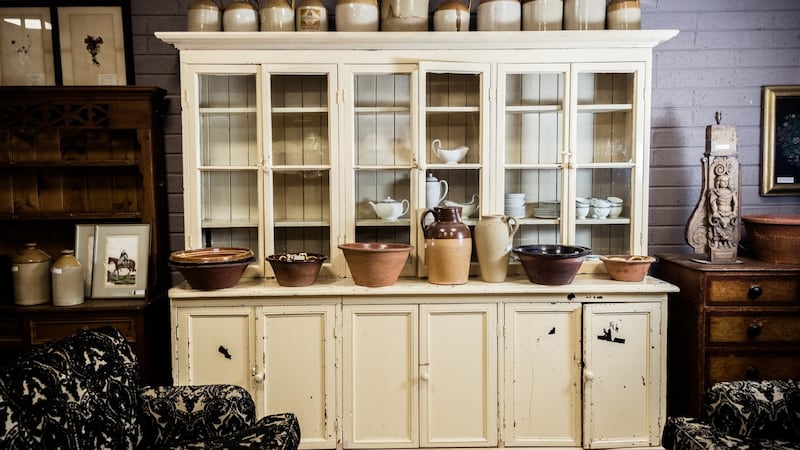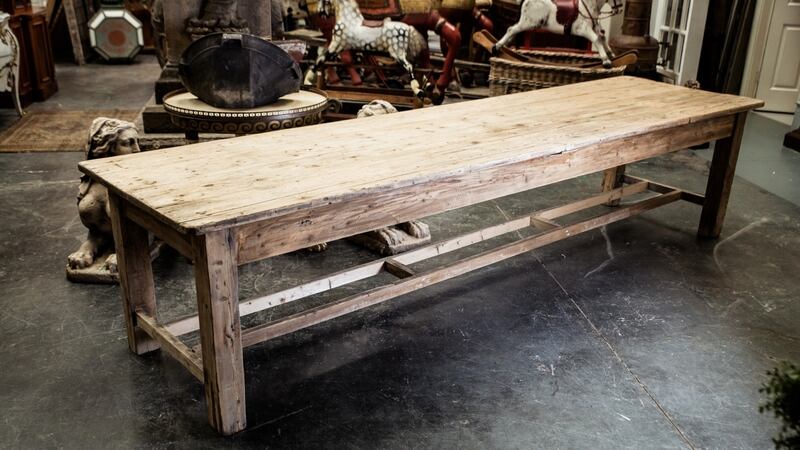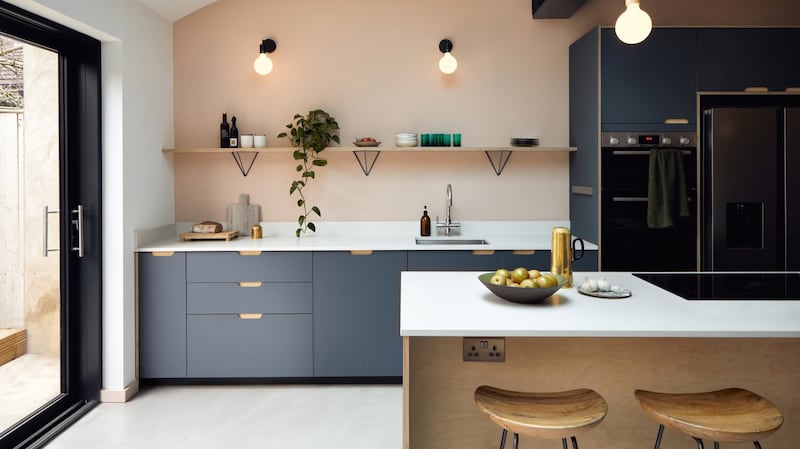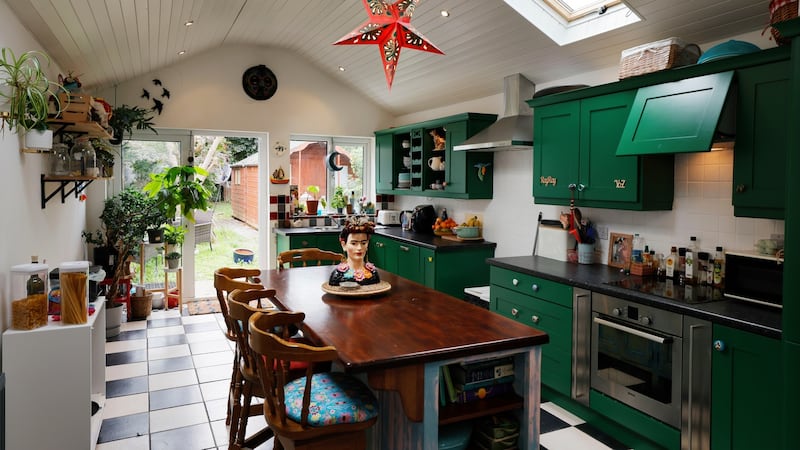Word on the street is that kitchen companies are so busy many can’t promise a new model until spring of next year. You can’t get an online slot with a design team for love nor money, so maybe it’s time to think differently by buying second-hand and doing your bit for the planet at the same time.
After making a home purchase, a kitchen is probably the next biggest outlay you will make. Prices for something brand spanking new vary hugely, from a modest €5,000 for scullery sizes to the sky’s the limit for bespoke joinery. Prices climb stratospherically once you add in-demand elements like an island or peninsula, stone countertops, swish appliances or a pantry and larder unit.
As the hardest-working room in the house its surfaces, drawers and hinges take dog’s abuse, but we as consumers ask very few questions about how long a kitchen should last and whether it’s repurposable when we want to change it. Many old models end up in a skip, broken down, their built-in nature making little of the materials or cabinetry repurposable or even recyclable.
As an era of conspicuous consumption is being brought to an end by short-term supply shortages and a longer-term need to rethink how we live (see the recent report by the United Nations Intergovernmental Panel on Climate Change), buyers want repurposable options.
Forget salvage yards
So where do you go to shop in a more eco-friendly fashion? Not at salvage yards, according to Gerard Thomas, manager of Mac’s Salvage, one of the capital’s biggest and best-known salvage yards. He says he gets calls every day asking if he will take second-hand kitchens.
“By the time you factor in labour and transport it isn’t worth the hassle. You have to take it out of the house, transport it and reinstall it here.”
He recommends Done Deal and suggests leaving the ad live for about two weeks.
He’s right. The smart money heads directly online to the rabbit hole that is Adverts.ie and to a lesser extent Done Deal as it now specialises in motors and machinery.
Demand for second-hand kitchens is booming, says Elaine Doyle, head of marketing at Distilled, the umbrella group for Done Deal and Adverts.
“At Adverts.ie we saw a big increase in the number of people selling kitchen items on adverts starting in June last year.
“In the 12 months to end of June ’21, ads placed in this section were up 57 per cent on the previous year and 55 per cent on the year before that .”
She attributes some of this spike in demand to lockdown renovation projects. The majority of these ads were placed in Dublin, with 99 per cent uploaded by private sellers; there are no real shops in this section of the web market, she explains.
Shop for a kitchen that is bigger than your own because some of the cupboards may not be fit for purpose or in a damaged state, is the advice of a former seller who used to operate a used kitchen shop in the west of Ireland. He advises buying one that you like the look of as it is, rather than hoping to reimagine it, and viewing it before you buy. He cautions against removing granite countertops without the help of someone with expertise in this field.


“It is heavy and difficult to deal with. It can be risky to move as it can crack or break.”
When he was in business, his stock was usually supplied by the builders contracted to install the new kitchens – but not all contractors do that work.
Ivan Honeyman of Honeyman Developments, a building contractor specialising in residential refurbishments, says there is no real value to a second-hand kitchen and he prefers if the client sells it.
“Then it’s gone when we go in to start the job.”
Circular system
Some companies, however, such as Noel Dempsey Design, are taking the initiative when it comes to reuse.
“We are starting to offer this circular aspect to clients who, after 10 years, want to change their kitchen,” explains director David Dempsey. “We will service it and replace anything that needs replacing and sell it on using 90 per cent or more of the design, reducing waste and landfill.”
The website, its name as yet unconfirmed, is due to go live in October so expect to see news on Noel Dempsey’s website and Instagram.
The easiest way to build a second-hand kitchen is to use free-standing furniture, and there’s a wealth of places to shop.
“If you use your imagination you can find things that can stand in for an island,” says Irish American photographer Maura McEvoy, whose new book, The Maine House (Vendome Press), captures this east coast sensibility perfectly. Her island is an old carpenter’s bench that someone put a bureau top on so that it has drawers on its inner side. She found it on a Pennsylvania antiques dealers’ site on Etsy and paid about $400 for it.

The Store Yard in Portlaoise is a resource that is a lot closer to home. There’s been a marked increase in demand for antique pieces with charm and character in kitchens, says manager Mark Flood.
“They are opting for free-standing rather than built-in units. Therefore country dressers, farmhouse tables and estate cabinets are all in high demand. We can’t keep country dressers and scrubbed pine tables in stock.”
If you still want to buy new, then before you purchase do plenty of due diligence on which brands can supply something that has an integral value, that is, it can be removed and installed in your new home or repurposed in some way in a different-shaped room. Leicht, a German engineered range, supplied by McNally, is designed to look like it is built in, but is formed in a way that means you can unhook it from walls and fixtures and take it with you when you move. That’s what German consumers demand, explains showroom manager Mary Orr, because accommodation there is usually rented unfurnished, minus even a kitchen.
Bulthaup, another German brand, offers an after-sales service once you purchase a kitchen, which means any hinges or door handles creaking under the work load can be repaired and maintained much as you would a car. While Siematic, also German, can be removed, no Irish customers have ever requested this service, says David Rafter of Arena Kitchens, which supplies the brand.
Warranties
Vendors of such services need to make consumers aware of these options. And consumers should ask about warranties on parts, too. Ikea, for example, offers a 25-year guarantee covering defects in the material and workmanship on its Metod kitchen, and there is a 10-year no-quibble guarantee on many of its hinges and parts. McNally can supply replacements on its designs that are still in production.
Hølte is a London company set up by two former high-end kitchen designers that now offers new door and handle options that work with Ikea kitchens and can also be designed to suit different existing carcasses. As well as being customisable, the firm has also measured the carbon used during every step of the manufacturing process and turned it into translatable data – like calories are to food – so consumers can make better-informed decisions. For example, 18sq m of a medium-size kitchen design in Tooting, London emit carbon levels equivalent to return flights to Paris.

Second-hand appliances may also be worth considering. Take any good second-hand appliances offered, is the advice of the former west of Ireland-based seller. By good he mentions “brands like Neff or Belling”, the rationale being that “you may even get a few years from them. Some of the cheaper new electric appliances are not worth it. They take longer to heat and in effect consume more electricity to do the same job, therefore costing you more money over its lifetime.”
And if you want existing appliances repaired you can look up local experts listed on Repair My Stuff.
adverts.ie; thestoreyard.ie; .mcnallyliving.ie; bulthaup.com/en/; arenakitchens.com; holte.studio; rempairmystuff.ie
Case study: Good deal on Adverts.ie

When Raychel O’Connell bought her first home in Crumlin she had to buy everything from scratch – she’d been renting and hadn’t a stick of furniture. Buying second-hand was not on her radar.
“While I liked quality, interesting pieces, I had only ever thought of vintage in terms of clothes, not furniture.”
Rising property prices have squeezed buyers’ budgets so many are opting to repurpose. The existing pine kitchen units were functional so she kept those, painting them an emerald green colour by Dulux. She also changed the handles.
“The units were in good condition and it seemed a shame to change them. I had always wanted a green kitchen and knew it would look great with the black-and-white tiled floor that was also already in place.” Three coats of paint and three years later and it still looks fresh.
The rest of the kitchen was furnished with items bought on Adverts.ie. She set up alerts for her shopping list of items, which saved endless scrolling. She wanted a pedestal circular dining table and an island and set up notifications for both – and even got into a bidding war over the island. It came out of a lovely country house in Meath, she recalls, and already had its walnut top and pine base. She ended up paying €150 for it – the price you’d pay for a brand new kettle and toaster set.
The breakfast bar stools came out of a pub that closed down in Wexford while the fridge, which she bought in Dublin, had something wrong with its fan. It was a minor problem that she managed to fix. She went to take a look at it first before committing to buying it, which she says is vital. She bought her microwave this way too. She paid €30 for it three years ago and it is still in good working order.
The dining table came from an older couple in Glasnevin who had reared their family around it and needed to get a bigger one to accommodate all their grandkids. It cost €30 and they were delighted it was going to a good home, she says. She’s even sent them photos of Christmas dinner around it to show them that it continues to be at the heart of a home.
All told she estimates the kitchen and fit-out, minus the units, cost between €600 and €700. This doesn’t factor in travel time or petrol driving to and from the pick-up points. Many of us will say we are too time poor to operate this way but, as Raychel points out, if you ordered a brand new kitchen there would be a wait period of between eight and 12 weeks on its delivery too.
As well as being affordable it has given them a space that tells a story that they can recall every time they sit down to dinner.












